Fig. 3.
Grand averaged Event Related Potentials (ERPs) time-locked to the onset of the three types of face stimuli (relevant, passive, and irrelevant). (Left) Younger participant data shows the largest P1 amplitude and earliest N1 latency for the relevant faces, followed by passive faces and then irrelevant faces. (Right) Older participant data shows that the relationship of the P100 amplitude and N1 latency of the ERP for irrelevant faces compared with passive and relevant faces has shifted, such that there is a selective-suppression deficit (see Fig. 1 for quantitative results). Topographical voltage maps show the distribution of the P1 and N1 to extrastriate areas. Although it may seem counterintuitive that the N1 amplitude is largest for the passive view condition, this may be a result of face processing across trials being most consistent in the passive viewing task compared with the memory tasks (time-locked consistency across trials would lead to a larger ERP amplitude). Because enhancement and suppression were not significant in the younger subjects, the N170 amplitude was not used as a measure for across-age group comparisons.

